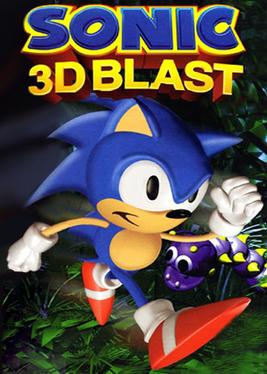
Sonic 3D Blast, known in PAL regions as Sonic 3D: Flickies' Island, is a 1996 platform game in the Sonic the Hedgehog series for the Sega Genesis and Sega Saturn. As Sonic the Hedgehog, the player embarks on a journey to save the Flickies, birds enslaved by Doctor Robotnik. The player must guide Sonic through a series of themed levels to collect Flickies and defeat Robotnik. Though it retains game mechanics from prior Sonic games, Sonic 3D Blast is differentiated by its 2D isometric perspective, with pre-rendered 3D models converted into sprites.

Earthworm Jim 2 is a 1995 run and gun platform video game and the sequel to Earthworm Jim, and the second and final game in the Earthworm Jim series developed by original creators Doug TenNapel, David Perry and Shiny Entertainment. It was released in late 1995 and early 1996 depending on region and video game console, initially being released for the Sega Genesis and Super Nintendo Entertainment System, before being ported to other platforms.

Pandemonium! is a 1996 platform video game developed by Toys for Bob and published by Crystal Dynamics for the PlayStation, Sega Saturn, Microsoft Windows, N-Gage, mobile and iOS. Pandemonium! features Fargus, a joker, and Nikki, a sorceress, who unwittingly casts a spell that destroys the town. The goal of the game is to reach the Wishing Engine, where they can wish the town back to normal. For each level, the player can choose which character to be. Each has a special move – Fargus can deliver a special spinning attack, and Nikki can double jump. The game consists of a great variety of unique gameplay objects, such as watermelons, clouds, spider webs and logs. A sequel, Pandemonium 2, was released in 1997 for PlayStation and Microsoft Windows.

Crusader: No Remorse is an action game developed by Origin Systems and published by Electronic Arts. It was first released in 1995 for MS-DOS, with the Sony PlayStation and Sega Saturn ports following in 1997. Set in a dystopian future 22nd century, the game centers on The Captain, a special ops officer and supersoldier, who defects from the tyrannical world government, the World Economic Consortium (WEC), and joins the Resistance rebels.
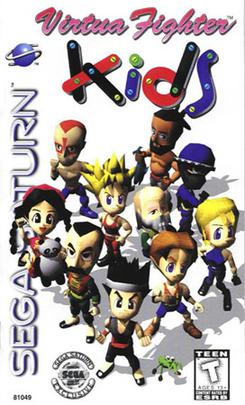
Virtua Fighter Kids is a 1996 installment in the Virtua Fighter fighting game series, and a super deformed version of Virtua Fighter 2. It was developed by Sega AM2 on the ST-V arcade board, unlike Virtua Fighter 2's hardware; it was also ported to the Sega Saturn home console.
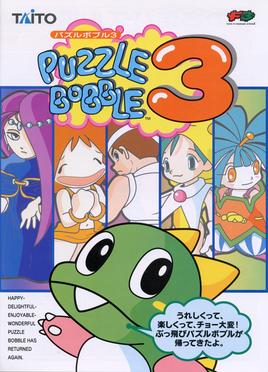
Puzzle Bobble 3 is an action puzzle video game developed by Taito. The second sequel to Puzzle Bobble, it was released for arcades in September 1996 and later ported to the Sega Saturn, PlayStation, Game Boy, Nintendo 64 and Microsoft Windows. Like its predecessors, the player is tasked with shooting balls at groups of balls, creating groups of three or more, which are then removed from play. Further ports for the Nintendo Switch, PlayStation 4 and Xbox One were released in February 2023 by City Connection alongside Puzzle Bobble 2.

Virtual On: Cyber Troopers is a 3D action video game developed and published by Sega. A robot-themed shooter and fighter, it was developed on the Sega Model 2 hardware and released on arcades in January 1996 before ports to the Sega Saturn that year and to Windows the next year. Initially the game was to be released under the title "Virtual On" in Japan and "Cyber Troopers" in North America, but ultimately these two names were combined into a single title for both regions.
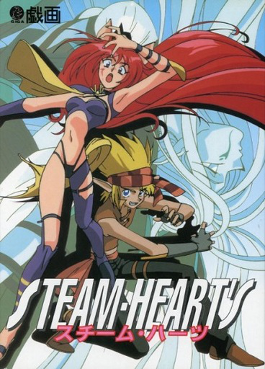
Steam-Heart's is a 1994 vertically scrolling shooter and eroge developed by Giga and published by TGL. The story follows two siblings as they fight off a virus that is possessing the people in their world. The game features shooter gameplay paired with ample erotic cutscenes with scantily clad women. Steam-Heart's was initially released on PC-98 personal computers on March 15, 1994; a version for the PC Engine Super CD-ROM² System was released in 1996 followed by another for the Sega Saturn in 1998, all of which were for the Japanese market. Critics generally found the gameplay to be average, with the erotic content being the sole distinguishing feature.

Shining the Holy Ark (シャイニング・ザ・ホーリィアーク) is a first person role-playing video game released in 1997 for the Sega Saturn. It is a part of Sega's Shining series of video games, and marked a new direction for the series, utilizing polygons as well as sprites for the visuals and a story targeted more specifically towards an adult audience. It introduced the saga of the Vandals and the Innovators, abandoning the saga of the Devil Kings which was followed by the previous installments of the series.
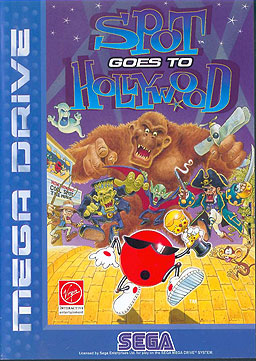
Spot Goes to Hollywood is a platform game developed by Eurocom and published by Acclaim Entertainment in North America and Virgin Interactive Entertainment in Europe for the Mega Drive/Genesis as the sequel to Cool Spot. Saturn and PlayStation versions were later released with full-motion video clips and isometric graphics. The player controls Spot, the mascot of the 7 Up soft drink, as he travels to various places trying to free his friends.

Loaded is a science fiction-themed top-down multidirectional shooter developed by Gremlin Interactive. Loaded was released on December 15, 1995 on the PlayStation, and was ported to the Sega Saturn the following year. The game had origins in DC Comics as well as the more adult-orientated Vertigo Comics, and there was a small graphic novel based on the game. The six playable characters of the game are a combination of villains, anti-heroes, psychopaths, perverts, mutants, and flamboyant murderers. They are, however, the best hope to stop the intergalactic supervillain nicknamed F.U.B. and save the universe. The characters were created and designed with contributions from Garth Ennis of Vertigo Comics and Greg Staples of 2000AD.

Alien Trilogy is a first-person shooter video game developed by Probe Entertainment and published by Acclaim Entertainment in 1996 for the PlayStation, Sega Saturn, and MS-DOS platforms. The game is based on the first three movies in the Alien film series. One of the first games developed by Probe following their acquisition by Acclaim, it debuted Acclaim's much-hyped motion capture technology. The game was well-received by critics, who praised its recreation of the films' atmosphere and its gameplay depth compared to other first-person shooters, and was a commercial success.

The Crow: City of Angels is a 1997 action video game for Sega Saturn, PlayStation and Microsoft Windows. It is loosely based on the movie of the same title. The player assumes the role of the hero of the film, Ashe Corven. The game was developed by Gray Matter, whose previous game was Perfect Weapon, which The Crow: City of Angels closely resembles in its basic mechanics. It was met with negative reviews.

Off-World Interceptor is a 1994 third-person vehicular combat video game, developed and published by Crystal Dynamics and originally released on 3DO. An alternate version of the game was later released for the Sega Saturn and PlayStation consoles, named Off-World Interceptor Extreme. The two versions of the game have identical core gameplay elements, though the Extreme version is tweaked to feel more like the arcade mode in the original Off-World Interceptor.

Space Jam is a sports video game that ties in with the film of the same name, and based on Looney Tunes characters by Warner Bros. It was released for the Sony PlayStation and Sega Saturn consoles, and MS-DOS computers. Unlike the film and real rules of basketball, each team plays 3-on-3. Players have a choice whether to play as the TuneSquad or the Monstars. It features basic controls and 2D graphics. The game was developed by Sculptured Software, who also developed the Looney Tunes-based basketball game Looney Tunes B-Ball for Sunsoft the year prior to the production of the Space Jam film, and published by Acclaim Entertainment, who also published the NBA Jam series of basketball games.

Ragnagard is 2D arcade fighting game developed by Saurus and System Vision, and published by SNK and Saurus for the Neo Geo arcade, Neo Geo CD and Sega Saturn. The game's characters are all based on Shinto deities.

CrimeWave is a vehicular combat video game, developed and published by Eidos Interactive, released as a Sega Saturn exclusive in 1996–1997.
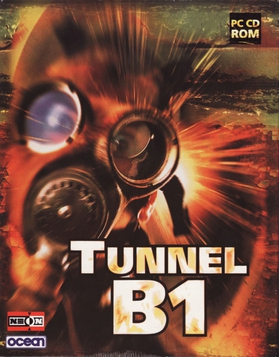
Tunnel B1 is a first-person shooter developed by NEON Software and published by Ocean Software in 1996. The soundtrack is by Chris Huelsbeck who also scored Turrican. The PlayStation and Sega Saturn ports were released in Japan as 3D Mission Shooting: Finalist.
Sky Target is a 1995 arcade game by Sega. A rail shooter featuring a number of planes including the default F-14D Super Tomcat, it is best remembered for its semi-official connection to Sega's earlier hit After Burner. Although never billed as a sequel, its overt similarities to the 1987 classic were nonetheless referenced in official promotional materials and recognized by the media. Plus, it features a revised version of the "After Burner" music theme within its soundtrack.
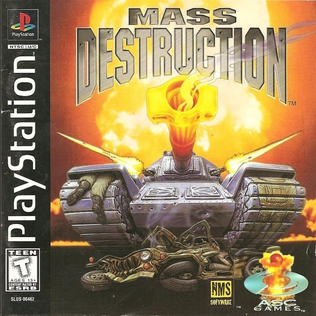
Mass Destruction is a 1997 third-person action game developed by NMS Software and published by ASC Games and BMG Interactive. Released for MS-DOS, the Sega Saturn, and the PlayStation, the game puts players in control of a tank, and tasks them with destroying enemy forces. It has often been likened to Return Fire.


















